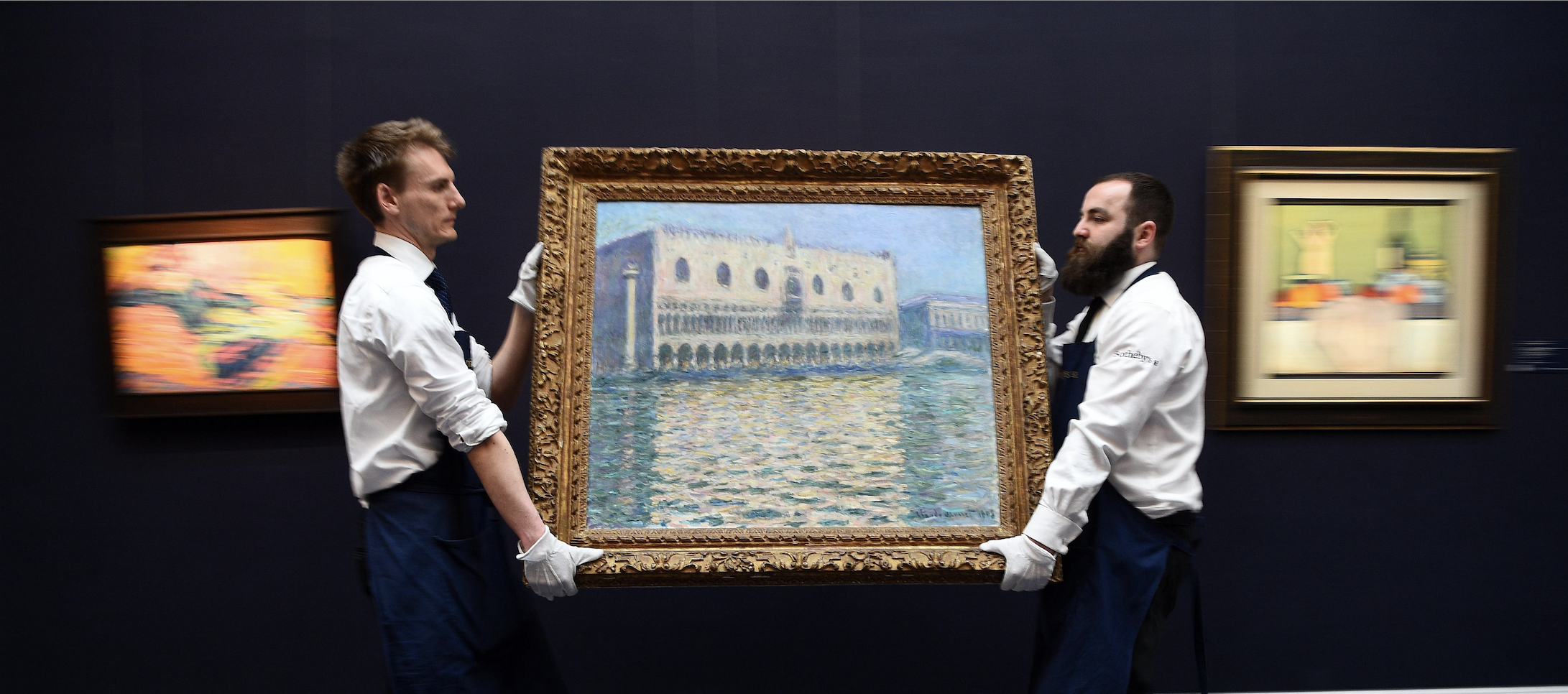
How To Sell Art
Whether you are an artist, collector, or beneficiary of an estate the question comes into play of where to sell this art and more importantly how? Here is a simple guide of the different ways to sell art.
How do Beginners Sell Paintings?
For the artists just starting out in their careers trying to sell their artwork may seem daunting, but it doesn’t have to be. The rapid growth and advancement of technology have greatly increased the ease of doing business. The advent of e-commerce has made it possible to buy and sell almost anything online, including artwork. Today buyers and sellers from all across the world meet in virtual marketplaces. You can very easily start selling your art online, promote it, and attract customers from all over the world.
It is possible to quit your day job and make art your full-time career. The “starving artist” is a mere myth and we’re here to show you how to keep that from becoming a reality.

Find Your Niche
Before you begin to sell your work online, it’s a good idea to find your niche and the unique style that sets your artwork apart from the rest. This will convey your strengths to your potential clientele and reflect who you are as an artist. It may be tempting to go broad with your art style choices but, by learning from experience you’ll have a much higher chance of success if you narrow down your style, medium, or theme to create or work within a niche.
Know Your Customer
It’s important to understand who your online consumers are and what they’re looking for in their search for online art. You need to know who it is you’re trying to attract and what exactly it is that they want. Pay attention when people compliment your work. Keep an eye on your social media too. Which posts have the most comments, likes, and shares? Do you receive feedback on the same art pieces time and time again? These are indicators that these are pieces of art that sell best to the people most likely to purchase them.
How Much Can I Sell My Art For?
When it comes to pricing your art, it’s important to research the various ways to do this while still making sure you don’t underprice or overprice your artwork. If you’re a beginner and have never sold your work before, rather than pulling random numbers out of the air, you may find it useful to use an art pricing formula, to begin with, and make adjustments as you grow. Additionally, research artwork that is similar in size, colors, and subject matter. Pricing needs to be fair to the artist and their time, but also realistic in regards to their market. A new artists’ market, which would be much less established, warrants a lower price than those of a larger market.
What are the Best Ways to Sell Art?
There are a number of ways to sell art. You can sell through an online marketplace like Etsy or a personalized artist website. Some artists choose to use their own social media as a way to sell art. There is also the more traditional route of selling through an art gallery and entering the higher levels of the art market in art fairs and art auctions. Let’s break these down.
- Sell art online
- Build an online store
- Create a storefront on an e-commerce site or an online gallery
- Sell art at an art fair
- Get represented by an art gallery
- Sell art at auction

How To Sell Art Online
For independent or emerging artists, art marketing is an important part of selling your artwork especially online. The artworld is saturated with fine artists trying to do the same thing.
How To Sell Art Through Social Media
You’ll find that it’s a lot easier to sell your work to an existing audience. If you use social media to connect and engage with the people who are interested in your artistic skill and already find your Instagram page inspiring, you’ll have a captive audience ready to sell to. Social media can act as a great tool to expand your reach to potential buyers and could attract the attention of art curators and dealers too.
Use platforms such as Facebook, Instagram, Twitter, even TikTok, whatever social media platforms you’re comfortable with at the moment, to tell people more about the new art you’ve produced, or are in the process of making. Although beware that mindless self-promoting doesn’t usually lead to sales. Instead, give your audience a sense of who you are as the person behind the art. Share behind the scenes, your art studio, or talk about the inspiration for your pieces. This will help them to build trust and confidence in you and your work.
If you’re asking yourself, how do I get my art out there? The social media channels below are the top choices because of their traffic, easy integrations, and seller protection.
Instagram is probably one of the largest used social media platforms and is also hyper-focused on visuals- perfect for selling visual art. Instagram also offers business accounts access to create an online storefront attached to your social account. People following your page or products can submit their payments via their preferred integrated software, like Paypal. This is a great feature for security and the likelihood of selling your artwork through a trusted platform that will also generate new followers.
TikTok
According to Wallaroo Media, TikTok receives over a billion monthly active users. This makes it a prime social platform for traffic to your own page. It is a platform that is powered through engagement and can help spread your niche and artwork to a broader community or even pair your work with the target audience through their helpful algorithm.

How To Sell Art Through Online Gallery
Online galleries such as Artsy, Saatchi art, and Artfinder offer artists the ability to sell their art on their designed platforms. This provides some relief as these platforms handle the sale of the artwork.
Now, this is not just for artists alone, art collectors alike selling artwork online is also a feasible option through these websites.
Many of these online galleries have different means to submitting artwork. We broke down the standards below as well as contact information.
Artsy
As per Artsy’s website, Artsy does not partner directly with artists. Instead, they offer partnerships with galleries, museums, and other institutions. If you were to work with a gallery, then they recommend getting in touch with them at [email protected].
Saatchi Art
Another option for an online gallery is Saatchi Art. This option is free to create an account and artists do not need to have gallery representation to be listed. According to their website, it is as simple as creating an account and uploading pictures of artwork with their descriptions.
Artfinder
Artfinder is an available resource for artists wanting to sell to an expansive community of over 500,000. The process is an application, where artists need to submit a personal statement and photographs of 4-6 examples, along with social media links. These are all aspects that Artfinder finds crucial to a successful page for selling art and should be considered even if this is not the online gallery an artist chooses.

How To Sell Art On An E-commerce Site
If you’re concerned about getting people to the website you build, many artists chose to start with creating a storefront on an e-commerce store or an online gallery. The benefit here is to tap into a network of consumers who are already searching for art to buy.
The easiest way for artists to begin selling on e-commerce sites is through Amazon, Etsy, and eBay. These sites offer artists the ability to create an online storefront of their own and promote it through their advertising channels. Etsy receives over 235M hits in monthly traffic, and there are a number of tools to analyze which products are getting the most love.
Top E-commerce Stores
- Amazon
- Etsy
- Ebay

How to Build an Online Store to Sell Art
If you already have your own website or online art portfolio but don’t want the involvement of a third-party marketplace, you can sell your work on your own website. Whether you sell your work in an online gallery or elsewhere, it’s still necessary to have your own website or online portfolio.
The design of your website should reflect your artistic style and act as a showcase for potential buyers and fans of your artwork. It should feature your best quality work and be a virtual representation of your brand. Artists can also coordinate their online stores with print-on-demand services for seamless workflow in expanding their art business.
Get Started with Easy Drag & Drop Sites
- Wix (Drag & Drop, best for beginners with no experience)
- SquareSpace (Best for beginners & designers)
- WordPress (Best for creators with website building experience)
Print on Demand Products and Sites
Print on demand websites is also becoming increasingly popular platforms for artists and designers to profit from their art. Once you’ve uploaded a high-quality image of your artwork, it can be printed on just about anything. The best part is after you’ve submitted your work, the website takes care of the rest.
Get Started by using some of these different print-on-demand sites.
- Society 6 – (best for illustrators, printmakers, photographers)
- Deviant Art – (best for character designers, and illustrators)
- Zazzle – (best for illustrators and designers)
- RedBubble – (best for illustrators and designers)
- Printful – (best for illustrators, printmakers, painters)

Selling Art at an Art Fair
This way of selling art is primarily geared toward individual artists. Art Fairs are an excellent way to showcase artwork and sell in live time. Art Fairs are expositions where artists, collectors, art galleries, art dealers, and curators all congregate to see what is blossoming in the art world. Many buyers prefer purchasing from an art fair because it provides a more accessible point of entry to purchase original artwork from burgeoning artists at a more reasonable price than through the secondary art market.
How to submit your art to an art fair?
Potential exhibitors send in their applications, along with the images of their work, their bios, their programs, and art fair history. The director of each fair reviews the application to curate the right groups of galleries for the fair. But each individual fair has its own specific components depending on the type of art they display, as well as the type of galleries that participate.
How much does an art fair booth cost?
The price of a booth at an air fair will vary depending on the application fees to enter the fairs and the square footage of the booth you choose to be in. Some of the smaller fairs will of course be cheaper- but thought into budgeting for transportation and installation when budgeting costs. Recommend looking into the different art fairs

Selling Art through a Gallery
Selling art through a brick-and-mortar gallery would be considered the next level up from a fair. Art Galleries particularly, depending on size, sell fine art through an artist representation or privately. Art collectors can approach an art gallery directly to inquire about selling their art.
The best way to do so is to inquire online through the gallery’s contact page and they will respond directly. As an artist seeking representation to sell, prepare a portfolio to send to the gallery of your original art. The gallery will then be in contact if they choose to represent.
Selling Art at an Auction
Selling at auction is best reserved for collectors rather than artists. Typical artworks found at auction are of high quality and are a favorite of gallerists and art buyers. We have previously posted a guide to auctions that outlines selling at an auction.
Art auctions are considered the highest point of the secondary art marketplace. This is where masterpiece original works, limited edition prints, and where art sales break seven figures. If interested in presenting an artwork or collection for sale, send an inquiry to the auction house and they will respond and conduct an appraisal round for consideration.
This content is for informational purposes only and not intended to be investing advice